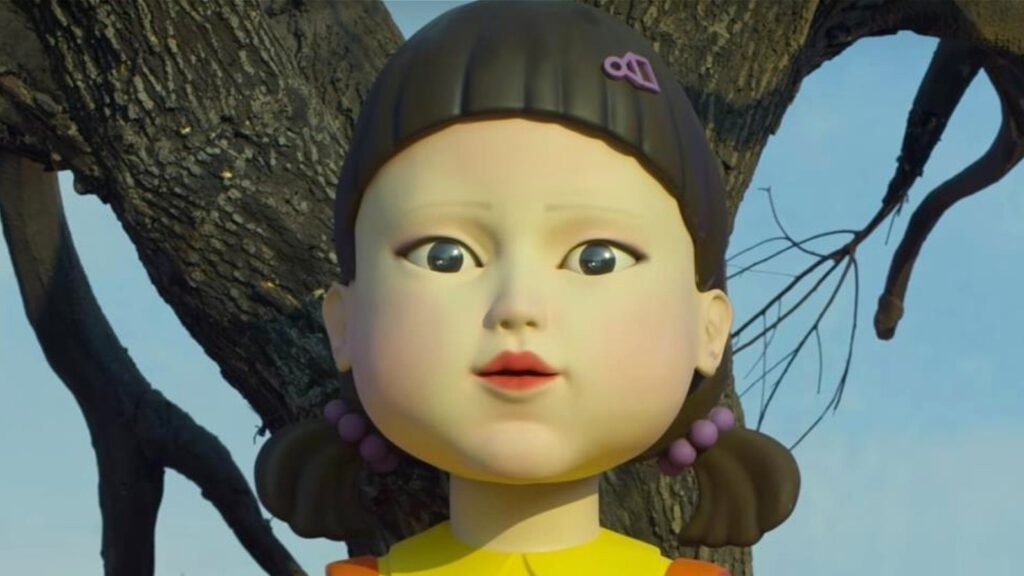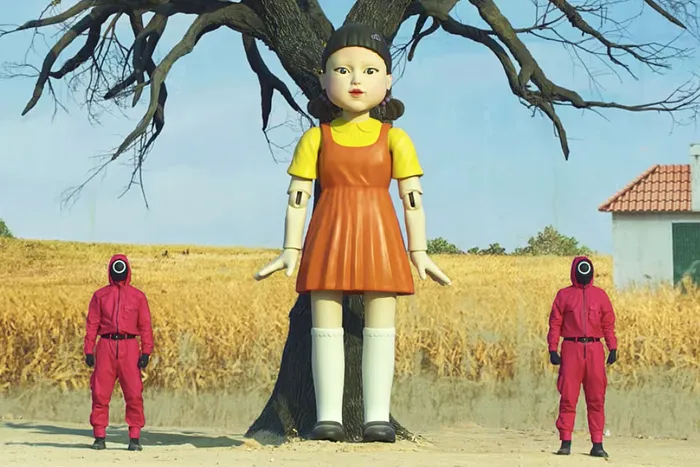In 2024, the Squid Game doll—infamously known as Young-hee—has returned to the spotlight with renewed force, not through episodes of gore but as a real-world animatronic figure priced at $399. This hauntingly familiar character, once feared on-screen, is now at the heart of a global marketing blitz, viral TikTok filters, and heated copyright showdowns.
From ancient Korean folklore to AI-generated voice kits and DIY build controversies, Young-hee has evolved into a complex cultural icon that continues to blur the line between pop art and psychological horror.
The Creepy Roots Behind the Squid Game Doll
While many associate Young-hee with Netflix’s Squid Game, her origins stretch far beyond the small screen. The concept is derived from a traditional Korean playground game called “Red Light, Green Light,” where children freeze when the caller turns around. Netflix reimagined this with brutal stakes and a 1970s-style animatronic schoolgirl dressed in eerie yellow and orange. She wasn’t just programmed to spot movement—she eliminated it.
This contrast between innocence and violence amplifies her chilling impact, deeply rooted in both cultural nostalgia and psychological manipulation.
2024 Merch Explosion: Netflix vs. Bootlegs
Netflix capitalised on the doll’s notoriety by unveiling a full-sized animatronic Young-hee for $399, complete with motion sensors and the haunting voice line “무궁화 꽃이 피었습니다.” The limited release ships in November 2024, and sold-out Funko Pops with glowing laser eyes only stoked fan frenzy further. However, this surge also triggered a massive crackdown on unofficial products.
Platforms like Etsy saw 83% of Squid Game doll listings vanish overnight due to DMCA takedowns issued by Netflix. The merch war has escalated beyond collector hype into a legal and economic battlefield.
How to Make Your Doll—Without Getting Sued
Despite Netflix’s attempts to stamp out replicas, creative fans continue to sidestep legal threats with modified 3D files. These STL files, often hosted in obscure maker forums, are tweaked just enough to dodge copyright claims while preserving the doll’s eerie aesthetic.
Builders mix RAL 3020 red paint with 8% matte medium for the signature look and use AI voice tools like ElevenLabs to replicate the Korean phrase in Young-hee’s robotic tone. Though controversial, this DIY movement thrives on accuracy and affordability, costing a fraction of the official doll.
Why the Squid Game Doll Still Haunts Our Dreams
Psychologists attribute the doll’s fear factor to more than just visual design. Her facial proportions feature eyes enlarged by 27%, which inadvertently mimic infantile features and trigger primal responses in viewers. Adding to the unease is a calculated 2.3-second lag in her head movement, giving people just enough time to anticipate dread without acting on it.
TikTok creators amplified this tension through the #DollChallenge trend, with over 4.7 million videos reenacting her deadly stare. It’s not just her look—it’s how she moves, pauses, and stares right through you.

Legal Chaos: Netflix vs. The World
In 2024, Netflix initiated a fresh wave of lawsuits to defend its hold on the Squid Game doll IP. Most notable was a $23 million judgment against Chinese bootleg factories that had mass-produced unauthorised Young-hee figures. Interestingly, Netflix lost a legal battle in South Korea when cultural scholars argued that the “Red Light, Green Light” premise was public domain folklore.
This clash between modern branding and traditional roots exposes the fragile legal ground beneath many iconic pop culture figures. Even Netflix can’t fully contain a character built on shared heritage.
Read Also: Best Horror Games on Roblox 2024
Conclusion
From viral TikTok filters to courtroom battles and $399 animatronic releases, the Squid Game doll has transitioned from fictional executioner to real-world obsession. Rooted in Korean folklore but magnified by Netflix’s global platform, Young-hee remains both a cultural touchstone and a marketing juggernaut.
Whether you’re crafting her from scratch, collecting merch, or decoding her symbolism, one thing’s clear—this doll isn’t going away anytime soon. So we ask you: Would you dare keep this doll in your home? Vote below and share your scariest Young-hee moment.
FAQs
What is the Squid Game doll’s real name?
Her name is Young-hee, inspired by 1970s Korean textbooks and traditional playground characters, giving her a retro yet unsettling charm.
Can you legally make a Squid Game doll replica?
Not exactly. While 3D printing her is technically legal using modified files, distributing or selling replicas may lead to copyright claims from Netflix.
Why is the doll from Squid Game so scary?
Her oversized eyes and unnatural movement hit deep psychological triggers, especially those related to the uncanny valley and threat anticipation.
Is the Netflix animatronic doll available worldwide?
The $399 doll is a limited release, with some shipping restrictions due to local toy safety laws and customs around electronic surveillance features.
Did Netflix win all lawsuits about the Squid Game doll?
No. While it succeeded in the U.S. and China, Netflix lost a Korean case due to cultural heritage laws protecting traditional games and icons.










